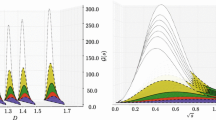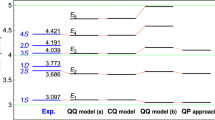Summary
A dual relativistic quark model is constructed for ππ and πN scattering amplitudes. The model has satisfactory high-energy behaviour and mass spectrum, no parity doubling on leading trajectories, and at a pole the leading-trajectory contribution factorizes into a product of collinearU 6 ⊗O 2 covariant vertices. The model is found to give satisfactory predictions fors-wave scattering lengths. It is also compared with the current algebra and partially conserved axial vector current predictions and is found to be compatible with them. The implications of the model for understanding the latter are also discussed.
Riassunto
Si costruisce un modello duale relativistico a quark per ampiezze di diffusione ππ e πN. Il modello ha spettro di masse e comportamento ad alte energie soddisfacenti, nessuno sdoppiamento dovuto a parità sulle traiettorie principali ed a un polo il contributo della traiettoria principale è fattorizzabile in un prodotto di vertici covarianti per la simmetriaU 6 ⊗O 2 collineare. Il modello dà predizioni soddisfacenti per le lunghezze di diffusione di ondas. Inoltre lo si confronta con le predizioni dell’algebra delle correnti e della conservazione parziale della corrente assiale e si trova che esso è compatibile con queste predizioni. Si discutono inoltre implicazioni del modello per capire queste ultime.
Реэюме
Для амплитуд ππ и πN рассеяния конструируется дуальная релятивистская модель кварков. Эта модель имеет удовлетворительное поведение при высоких знергиях и массовый спектр. В модели отсутствует удвоение четности на главных траекториях, и в полюсе вклад главных траекторий факториэуется в проиэведение коллинеарныхU 6 ⊗O 2 ковариантных верщин. Получается, что зта модель дает удовлетворительные предскаэания для длинsволнового рассеяния. Полученные предскаэания сравниваются с предскаэаниями алгебры токов и частично сохраняюшегося аксиального векторного тока. Обнаружено раэумное согласие между зтими предскаэаниями. Также обсуждаются следствия зтой модели для интерпретации частично сохраняюшегося аксиального векторного тока.
Similar content being viewed by others
References
R. Oehme:Nucl. Phys.,16 B, 161 (1970).
S. Mandelstam:Phys. Rev.,184, 1625 (1969);K. Bardakci andM. B. Halpern:Phys. Rev.,183, 1456 (1969).
R. Carlitz andM. Kislinger:Phys. Rev. Lett.,24, 186 (1970).
J. P. Lebrun andG. Venturi:Nuovo Cimento,68 A, 691 (1970);G. Venturi andW. J. Zakrzewski:Nuovo Cimento,69 A, 431 (1970).
K. Bardakci andM. B. Halpern:Phys. Rev. Lett.,24, 428 (1970);J. P. Lebrun:Lett. Nuovo Cimento,3, 819 (1970).
G. Venturi:Lett. Nuovo Cimento,3, 753 (1970);Nuovo Cimento,1 A, 759 (1971).
This symmetry has also been shown to arise naturally for both meson and baryon vertices, even if the masses break the symmetry, through the saturation of superconvergence relations. SeeG. Venturi:Phys. Rev.,161, 1438 (1967);163, 1826 (1967). Thus, considering the original motivation of the dual model from superconvergence relations and finite-energy sum rules (seeG. Veneziano:Nuovo Cimento,57 A, 190 (1968)), it is natural to associate it with collinearU 6 invariant vertices.
J. P. Lebrun andG. Venturi:Lett. Nuovo Cimento,4, 1133 (1970).
B. Sakita andK. C. Wali:Phys. Rev.,139, 1355 (1965). We shall use the brokenU 6 scheme suggested in this paper.
S. Weinberg:Phys. Rev. Lett.,17, 616 (1966).
K. Kawarabayashi andM. Suzuki:Phys. Rev. Lett.,16, 255 (1966);Riazuddin andFayyazuddin:Phys. Rev.,147, 1071 (1966).
S. Mandelstam:Phys. Rev. D,1, 1734 (1970);P. G. O. Freund andR. Waltz:Phys. Rev.,188, 2270 (1969).
J. A. Cronin:Phys. Rev.,161, 1483 (1967);H. S. Mani, Y. Tomozawa andY. P. Yao:Phys. Rev. Lett.,18, 1084 (1967).
The functionsV μ (−α(s),n −α(t)) may be expanded as (ref. (6))\(V_\mu ( - \alpha (s),n - \alpha (t)) = \sum\limits_{l = 0}^\infty {\frac{1}{{(l - \alpha _s )^\mu }}\frac{1}{{l - \alpha (s)}}} \frac{{\Gamma (\alpha (t) + l + \mu + 1 - n)}}{{l!\Gamma (\alpha (t) + \mu + 1 - n)}}\) and similarly forV 'μ . We note that the terms in the series forl large behave asL α(t-n-1, so, in general, the convergence is sufficiently rapid, in the cases we consider, that only the first few terms need be taken into consideration.
T. P. Cheng andR. Dashen:Phys. Rev. Lett.,26, 594 (1971).
Author information
Authors and Affiliations
Additional information
Work supported in part by the Istituto Nazionale di Fisica Nucleare.
Rights and permissions
About this article
Cite this article
Venturi, G. Low-energy aspects of a dual relativistic quark model. Nuov Cim A 6, 499–515 (1971). https://doi.org/10.1007/BF02723382
Received:
Published:
Issue Date:
DOI: https://doi.org/10.1007/BF02723382




